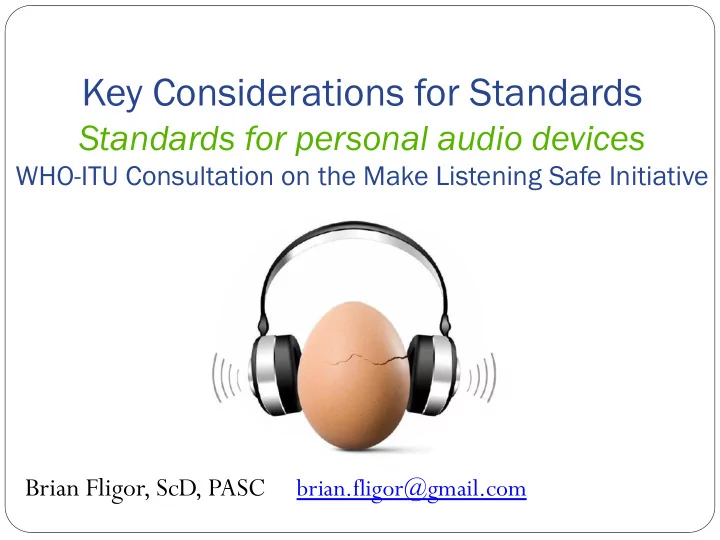

Key Considerations for Standards Standards for personal audio devices WHO-ITU Consultation on the Make Listening Safe Initiative Brian Fligor, ScD, PASC brian.fligor@gmail.com
WHO-ITU Risk Assessment and Definitions Subgroup Experts in academia, industry, public health: Ian Wiggins, Jeremie Voix, Warwick Williams, Peter Thorne, Richard Neitzel, Christian Giguère, Christian Huggonet, Chuck Kardous, Michael Santucci, and Brian Fligor Guidance and participation from Shelly Chadha for WHO
Purpose of Subgroup on Standards for PAS Provide guidance to PAS manufacturers, end users, and public health professionals how to provide and use tools to make PAS use safer Guidance in the form of written reports, reviews, and critiques from the scientific literature Gap analysis Current scientific consensus Acknowledgement of limitations of current knowledge
Key Considerations for Standards for PAS The use of PAS poses some risk for non-occupational noise-induced hearing loss (NIHL): this is despite efforts for level-limiting earphones, Android device warnings, and EU standards for maximum PAS output There is benefit to using PAS, and there is a dose-effect relationship between level and benefit Rubinelli et al (Listening Habits review): excitement, relaxation, concentration, define personal space (“urban sherpa ”), combat boredom Ambient noise in listening environment further influences chosen/preferred listening level
Key Considerations for Standards for PAS Seminal studies of dose-effect relationship in occupational NIHL provide baseline guidance (“Damage Risk Criteria”) Limitations of generalizing occupational noise exposure to non-occupational noise exposure Durations of exposure (40-year working lifetime vs. lifespan) Threshold for “acceptable” risk No clear dose-effect relationship between noise exposure and onset of bothersome tinnitus (or other auditory injury; e.g., hyperacusis, diplacusis)
Key Considerations for Standards for PAS Framework of solutions: Dosimetry, rather than level-limiting, is thoroughly supported in the scientific literature as the appropriate metric for dose-monitoring/NIHL risk Level limits against acute acoustic trauma Current PAS technology has the capacity to provide dosimetry metrics, with some definable error Best-practices in health communication can draw from multiple fields to craft the information provided to end users Product packaging, IFU, User Interface, Parental Controls
Next Steps, Standards for PAS Agree upon framework for standards Dosimetry (with upper threshold for level-limit) Health communication driven interface with end user Ability to integrate data to learn from and improve standards, screening protocols, user behaviour Messaging from public health respects user autonomy while holding to accurate information Manufacturers given freedom to innovate within the standards’ framework Update the standards, as a living document, as new knowledge becomes available
Recommend
More recommend